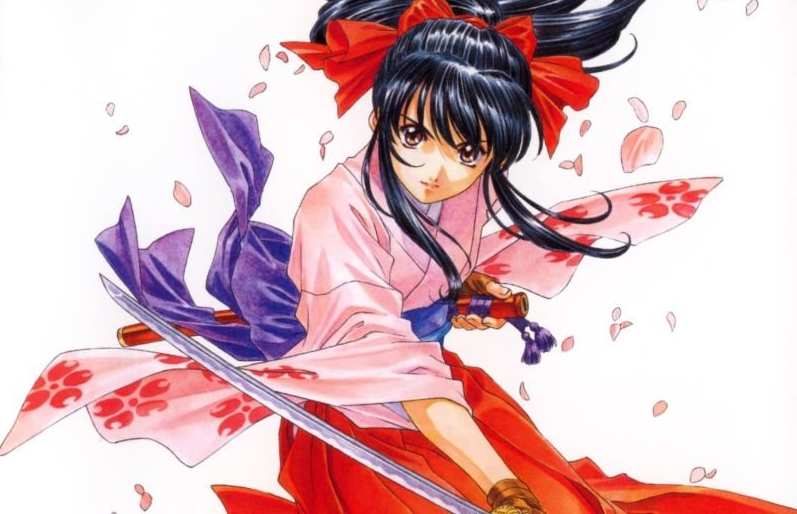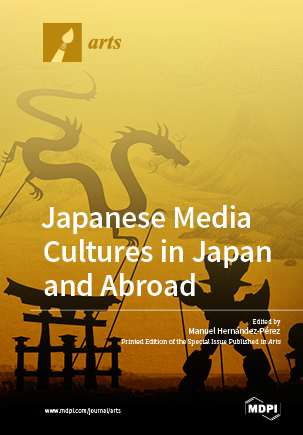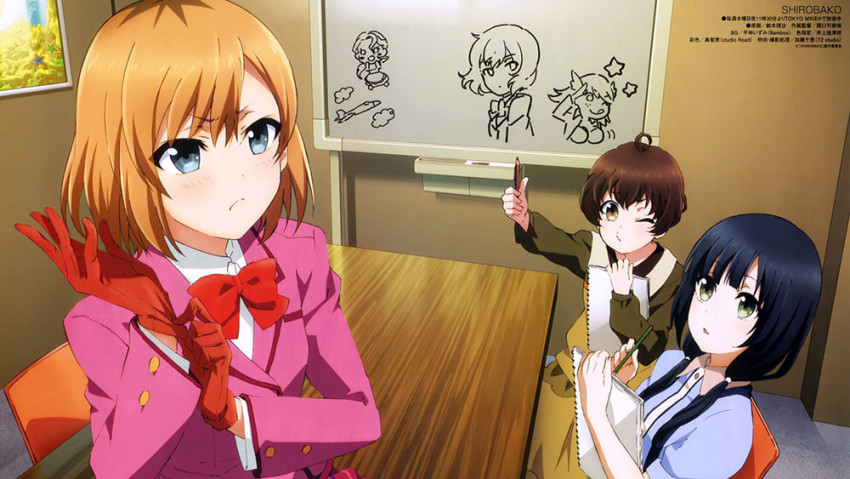Books: Japanese Media Cultures
July 10, 2019 · 2 comments
By Jonathan Clements.
 Originally appearing as two issues of the online journal Arts, Japanese Media Cultures in Japan and Abroad: Transnational Consumption of Manga, Anime and Media-Mixes, edited by Manuel Hernández-Pérez, makes a brave stab at defining a number of important baseline issues in the study of anime and manga. It does contain several tooth-itchingly precious attempts to coin new buzzwords (spare us, please, any more papers using the term animesque), but also some valuable considerations of elements of contemporary Japanese media around the world, from Marco Pellitteri on the journey of “cute” culture from Japan to Europe, to José Andrés Santiago Iglesias on early Euro-Japanese co-productions and their influence.
Originally appearing as two issues of the online journal Arts, Japanese Media Cultures in Japan and Abroad: Transnational Consumption of Manga, Anime and Media-Mixes, edited by Manuel Hernández-Pérez, makes a brave stab at defining a number of important baseline issues in the study of anime and manga. It does contain several tooth-itchingly precious attempts to coin new buzzwords (spare us, please, any more papers using the term animesque), but also some valuable considerations of elements of contemporary Japanese media around the world, from Marco Pellitteri on the journey of “cute” culture from Japan to Europe, to José Andrés Santiago Iglesias on early Euro-Japanese co-productions and their influence.
Editor Hernández-Pérez analyses what has been written about anime and manga in different languages, which throws out some interesting statistics, starting with the fact that while anime publications have continued to steadily rise, writings on manga took a sudden, precipitous drop after 2017. Perhaps surprisingly to some, there is as much written about anime and manga in United States academia as is written in Japan, with the United Kingdom in third place. There is also slightly more written on the subject in humanities faculties on Taiwan than in those in the whole of the People’s Republic of China, although I have some personal experience that can speak to this. I’ve made several attempts to rope Chinese academics into writing about Japanese animation in their country, but in jumpy political times, many proved reluctant to even have the word “Japan” turn up on their resumés. I’ve often shared lecture halls with entire cliques of Chinese Naruto fans and Shinkai-lovers, but few of them wanted to be outed.
 A large proportion of the book gets bogged down in definition, circling around the question of what manga and anime actually are. This is, of course, a question well worth asking, far more complicated than the average fan is likely to believe, and one with which other publications fail to engage at their peril. Hernández-Pérez, in particular, is keen to establish that regardless of the Japan connections most obviously manifest, investigations of the sales, contexts or cultures of anime and manga must grapple with the fact that they are not simply, say, “comics and cartoons from Japan” but transnational, transmedia phenomena – toys and games and knick-knacks, made in Malaysia or Taiwan or Scotland.
A large proportion of the book gets bogged down in definition, circling around the question of what manga and anime actually are. This is, of course, a question well worth asking, far more complicated than the average fan is likely to believe, and one with which other publications fail to engage at their peril. Hernández-Pérez, in particular, is keen to establish that regardless of the Japan connections most obviously manifest, investigations of the sales, contexts or cultures of anime and manga must grapple with the fact that they are not simply, say, “comics and cartoons from Japan” but transnational, transmedia phenomena – toys and games and knick-knacks, made in Malaysia or Taiwan or Scotland.
In other words, they mean different things to viewers in Latin America or toy-buyers in Germany, and encompass not only multiple genres, but also multiple areas of interest and competency. In another essay in the book, Jacqueline Berndt delves into what that might mean for teaching. If a lecturer throws Sakura Wars into a class discussion, how and why? Is it an assigned reading of the manga? A playing of the game? A screening of an episode? And if so, what are we illustrating, here? Is it the exuberance of the Taisho era or the depth of Japanese racism? Is it the carnivalisation of history or the allegorisation of 1920s politics? Or the way it’s drawn? Or how it makes us feel…? Classroom hours are limited, and Berndt poses a critical question for the use of anime and manga in colleges – what are they for?
Hernández-Pérez and Berndt, along with Alba Torrents on the media-mix, dance around “boundary disputes” (see here, p.73) within the anime studies community, as specialists from different disciplines squabble over what should be studied and why. There is a bit of hand-wringing here about the influence enjoyed by people who speak Japanese, as if learning one of the world’s most difficult languages creates some sort of unfair privilege in the field of writing about media made in it. Anime is not an easy grade, although I am sure many of the people lured to it would rather prefer that it were.
Academics don’t need to speak Japanese to have a worthwhile opinion on Japanese media, but it really helps. I’ve lost count of the number of times I’ve been asked to peer-review some fretful nonsense by someone who lacks the ability to read the materials that would answer many of their supposed research questions before they even asked them. If only, they muse, we had some idea of what Mamoru Oshii’s intention was in such-a-such a scene. I’ll point out he gave a six-page interview in Animage about it, and everybody goes off in a sulk.
 An article by Stevie Suan, however, points to the most notable exception to this rule: sakuga fans. This growing sector of anime appreciation highlights the artwork itself – fixating productively and intensely on the materiality of animation and the skills of its creators. Again, it certainly doesn’t hurt if you can read enough Japanese to understand what artists might write about their work, but the art-for-art’s-sake attitude of sakuga fandom offers the opportunity to examine anime for its pure content – the drawings themselves. Suan chooses to discuss sakuga fans through the particular prism of Shirobako, an anime show about the making of an anime show.
An article by Stevie Suan, however, points to the most notable exception to this rule: sakuga fans. This growing sector of anime appreciation highlights the artwork itself – fixating productively and intensely on the materiality of animation and the skills of its creators. Again, it certainly doesn’t hurt if you can read enough Japanese to understand what artists might write about their work, but the art-for-art’s-sake attitude of sakuga fandom offers the opportunity to examine anime for its pure content – the drawings themselves. Suan chooses to discuss sakuga fans through the particular prism of Shirobako, an anime show about the making of an anime show.
Zoltan Kacsuk similarly ponders the meaning of the word manga. Since there is always some chancer ready to tell you that “manga can come from anywhere” in the hope you’ll give his big-eyed vampire comic a try, Kacsuk’s reasoned and richly cited account is valuable indeed. Ironically, however, Kacsuk doesn’t appear to have noticed the flipside of the linguistic privilege mentioned above, which is that just because someone speaks Japanese, it doesn’t make them an expert on manga. He refers, for example, to a Japanese ministry’s “more inclusive notion of manga”, without considering that nobody at the organisation in question stopped to think if the word manga meant the same thing in English as it did in Japanese. That aside, it’s great to have so many of the more thoughtful thinkers on manga corralled into a single place, and also amusing to revisit some of the very worst in empty pseudery, including one of my favourite bits of bullshit: “In Western comics we read what happened next; in manga we read what is happening right now.”
With so much discussion on fundamentals, there’s not a whole lot of space left to talk about actual issues of content. Fortunately, however, some punchy contributors step up to the plate with some truly interesting pieces. Álvaro David Hernández Hernández (so good they named him twice) investigates the activities of the Kadokawa Dwango corporation in the years 2010-16, a period of immense transformation in the way that media were bought, sold and distributed. In an illuminating touch, he brings in the writings of Tsuguhiko Kadokawa on matters in post-modern copyright and media distribution – with a panache echoing that of his more notorious brother Haruki, he compares the advent of Netflix to the coming of the predatory Black Ships to samurai-era Japan. There is much of great interest here on matters of streaming and intellectual property, as well as the mechanics of contemporary production and integrated platforms.
A significant modern trend in the Japanese media mix, still only in single-digit percentiles but growing all the time, has been the promotion of live “events”. Concerts, operettas and musicals based on big-name franchises offer licence holders the holy grail in modern media: an experience that can’t be pirated. Shiro Yoshioka offers a valuable account of such “2.5D” theatrical performances of franchises including Prince of Tennis and Sakura Wars, recounting not only the nature of their performance, but also changes in audience expectations over the last decade. I saw him give a previous version of this paper some years ago in Norwich, where he focussed on his own personal experience of attending. Sadly, for a more serious venue, he has stripped out a lot of this in favour of comments more grounded in the work of other academics, but he still brings a welcome perspective to a facet of the “anime and manga” world that is little discussed. Along with two recent essays I highlighted in Berndt et al’s Shojo Across Media, it marks some of the most innovative work on the “Japanese media mix” I’ve read this year.
And here’s the thing, reading this book will cost you nothing. It has been released as an Open Access PDF download, which means that, for a nice change, I haven’t had to spend £90 acquiring something I review. Instead of pay-walling their work off for a price so prohibitive that hardly anyone will see it, these authors have offered it up for free. This, in itself, is sure to ensure that their thoughts and ideas are much more widely read, not only in anime and manga academia, but in the fields just beyond its fuzzy borders, by the academic writers of the future.
Jonathan Clements is the author of Anime: A History. Japanese Media Cultures in Japan and Abroad: Transnational Consumption of Manga, Anime and Media-Mixes is available for download from MDPI Books.
JD
July 10, 2019 1:44 pm
Whilst it's great that this "book" is being given away for free, and whilst you didn't have to pay for it to review it, you do realise that as an author yourself, that this now sets a dangerous precedent, and will only end-up harming you (as an author) in the longer term? Publishers will still want you to write stuff, like journalists did, but then expect you to do it for free. You're basically writing yourself out of a job! Blogging and journalism, and doing that for free, doesn't keep you well-fed, with a roof over your head! It won't pay your bills. It won't let you live, if companies now start expecting you to do the same as these authors. So many forms of writing are now being done for free, that it's killing the industry off. I'm sure you don't want that to happen, yet here you are posting the virtues of ending the very industry that you yourself derive a living from. Why would you be doing that?!
Eccentric Fanboy
October 21, 2020 4:09 am
This is very late, and you might not even see it, but academics don't get paid for writing in academic collections like this, whether the book is free or not. They only get paid (and even then, just a small sum) for editing collections and for writing monographs. In general, academic publishing is entirely set up to financially benefit the publishers, not the authors.